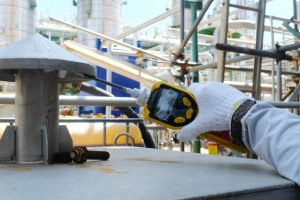
A proactive, continuous program to detect and evaluate workplace risks is a key part of any occupational health and safety program. For almost 40 years, GBTS has been assisting clients of all types to identify risks and hazards and to create and maintain a safer workplace. Our mission is to partner in the effort to move workers to retirement healthy and whole.
Under the Occupational Safety and Health Act, employers have a duty to provide a workplace free from recognized hazards, regularly assessing workplace conditions to verify compliance with OSHA standards and industry best practices.
Our safety and industrial hygiene consulting teams are led by senior professionals certified by the Board of Global EHS Credentialing (BGS) and the Board of Certified Safety Professionals (BCSP).
GBTS will assist in the anticipation, recognition, assessment, control and confirmation of protection of workplace hazards to protect your greatest asset, your workforce. Our professional staff has provided these services to clients in the manufacturing, transportation, health care, construction, utilities, and commercial property industries.
Workplace Exposure Assessments
Exposure monitoring evaluates potential hazardous materials in the air or on surfaces in the workplace. GBTS will work with your organization through our industrial hygiene services to identify potential exposure risks associated with the materials and equipment used in your processes.
Exposure monitoring is a proactive approach to protecting workers’ health and safety, complying with regulations and continuously improving the working environment. Monitoring provides information for the implementation or evaluation of hazard control measures, verification of engineering controls, and reduction of workers’ compensation cost.
GBTS offers industrial hygiene monitoring to assess common hazardous substances, including:
- Silica
- Metal dusts and fumes
- Volatile organic materials (paints, thinners, inks, solvents, adhesives)
Noise, or unwanted sound, is a frequent physical agent hazard in the workplace. Excessive exposure to elevated noise levels can lead to noise-induced hearing loss (NIHL). GBTS evaluates employee noise exposures through industrial hygiene sampling techniques like audiodosimetry for comparison to the OSHA Noise Standard. Exposures above the OSHA action level trigger the need for a Hearing Conservation Program designed to protect workers from hearing impairment. Sound level mapping identifies high noise areas and processes.
GBTS also provides industrial hygiene testing and consultation on risks associated with non-ionizing radiation, temperature extremes, and ergonomic factors.
Safety Audits/Assessments
An audit will generally include a desktop review of programs, policies, materials in use, injury and illness records, and any potential citations/violation notices. The document review will be followed with an onsite visit to observe actual operations and equipment, compliance with programs and policies, safety devices and personal protective equipment in place, and identification of areas for improvement.
any potential citations/violation notices. The document review will be followed with an onsite visit to observe actual operations and equipment, compliance with programs and policies, safety devices and personal protective equipment in place, and identification of areas for improvement.
Our industrial safety consultants provide audit reports that include a color-coded hazard risk ranking to assist clients in prioritizing efforts.
Benefits of a safety assessment include:
- Early detection and mitigation/elimination of risks and hazards
- Identification of areas of improvement
- Demonstration of commitment to employee health and safety
- Verification of compliance with applicable safety regulations
GBTS can assist in the development of site-specific safety programs, as well as develop and present industrial safety training and construction health and safety training for employees both in-person and virtually.
Common hazards and/or programs evaluated include:
- Machine Guarding

- LockOut/TagOut (including machine-specific procedure development)
- Electrical Safety (70E, Arc flash)
- Dust Hazard Analysis
- Ergonomic Assessment (Industrial, Office and Home settings)
- Hazardous Materials
- Amusement Park Safety Inspections
GBTS can assist in response to OSHA inquiries and/or citations, ensuring appropriate remediation activities are identified. Our industrial hygiene consulting services help achieve compliance with OSHA standards and promote long-term workplace safety.

